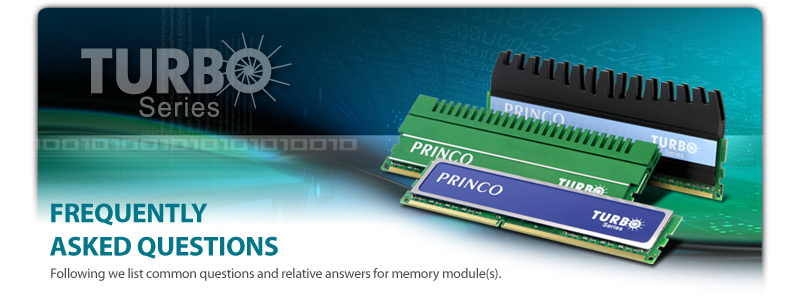|
 |

|
| Q1: |
What is the meaning of DDR3-1800 labeled on the Memory module? |
| A : |
DDR3-1800 means the data transfer rate is 1800 Mbit/sec. Memory module with higher data transfer rate has better performance. |

| Q2: |
What is the meaning of CL 8-9-8-24 labeled on the Memory module? |
| A : |
The CL 8 is CAS Latency, which is the time (in unit of clock cycle) required for the DRAM to prepare the data after the command is received. The -9-8-24 are DRAM’s internal timing constraints. Shorter latency (smaller value) will result in better system performance. |

| Q3: |
Can we use two PRINCO’s single-pack modules together for dual-channel purpose? |
| A : |
Yes, PRINCO’s same-data-rate “single-pack” modules are guaranteed 100% for dual / triple channel configuration. However, it is not recommended to mix with different spec. modules, since the system might have troubles in computer booting and BIOS setting. |

| Q4: |
Can we gain more performance by applying higher voltage to Memory module? |
| A : |
We don’t recommend users to do so. Higher voltage may have better performance; However, higher voltage might result in system instability and impact the long-term reliability. The working voltage, suggested by PRINCO, has verified by our expert engineers that the memory module has largest noise margin accompanied by its lifetime performance. |

| Q5: |
When I plug-in the memory module, why does it boot with standard SPD setting? |
| A : |
Most motherboards use 1066 or 1333 MHz as default SPD setting. All you have to do is enter BIOS setting and load the built-in parameters in SPD. Please refer to the BIOS setting instructions provided by PRINCO [ Click here ]. It is simple and handy. |

| Q6: |
Can we overclock the memory module to higher frequency? |
| A : |
PRINCO’s memory module is tested and verified under much higher frequency than the labeled specification. This is to guarantee that the DRAM could operate properly, even in the worst case of the mainstream motherboard. However, considering the long-term stability, we don’t recommend users to do so. |
|
|

 |
|
